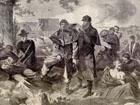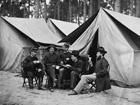When the war began, medical practitioners did not know the exact cause of many diseases or the mechanisms of infection, and were only beginning to understand the benefits of cleanliness and good sanitation in disease prevention and healing. As a result, two out of every three deaths in the Civil War were caused by disease rather than injury. Caregivers like Clara Barton, the "Angel of the Battlefield," brought food and supplies to the soldiers and inspired new hope and life to the injured.
-
Article 1: The Reason Medical Practices Changed

The technology during the Civil War was changing rapidly and it seems like the medical practices were lacking. Soldiers were being injured at a much higher rate but disease was another major reason soldiers were dying. Read more
-
Manassas National Battlefield Park
Article 2: From The Front Lines to the Hospital

For the wounded near the front, their first recourse for care lay at the numerous aid stations scattered across the battlefield. Farmhouses, barns, and outbuildings provided places for the wounded to be gathered until they could be sent to the main hospital in the rear. Read more
-
Article 3: Taking Care of Those in Need

Taking care of the wounded and sick soldiers of the Civil War was taken on my civilians and military professionals. Civilians helped out with a variety of tasks in a hospital, while the doctors tried their best with the large numbers of casualties. Read more
-
Clara Barton National Historic Site
Article 4: Organization is Key

Some civilians, like Clara Barton, took supporting the war into their own hands, while other formed and medical support organizations. Read more
-
Article 5: Medicine and Medical Practices

The story of Civil War medicine is a complex one. Through the dedication, innovation and devotion of surgeons and medical support staff, the foundation for today's modern military medicine was laid. Read more
